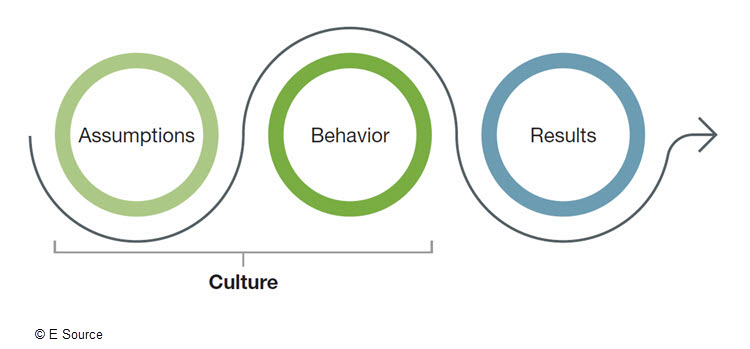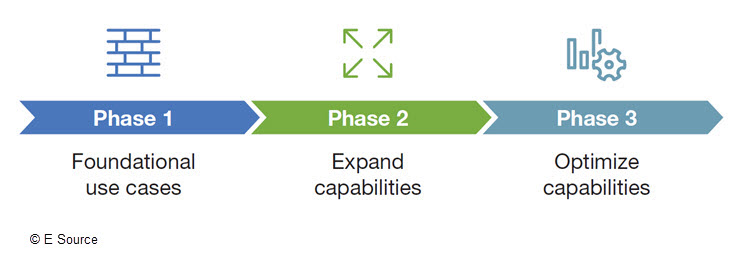
The utility of the future will be fully digital. And making that transition requires you to radically rethink how your people, processes, data, and technologies will affect business performance. To extract value from digital investments, you need specialized skill sets to transition from collecting data to connecting data.
Today’s utilities will need to develop digital strategies that employ a human-centric approach and technology roadmap to optimize business benefits for their data and technology-focused initiatives. Fortunately, companies that have already started the process offer lessons that can inform your efforts. To help you maximize value from digital investments, we’ve put together five tips to get you started.
Make sure stakeholders are on board with your business strategy
Getting the right strategic vision is critical. People want to know where the organization is going, and lack of alignment is often a key barrier to success. It’s hard to describe alignment or how to create it. And you can’t measure alignment—you can only sense it. Leading a group from “We each think this” to “We all agree to do that” can be like finding your way through a maze that unfolds at each turn. Alignment research has shown that groups of 2 to 10 people have, on average, more than 140 unique and relevant opinions on one topic.
To ensure success, have a clear vision from the beginning. This requires aligning your organization on:
- Your vision and overarching goals
- Understanding unintended consequences, barriers, and risks
- Assumptions about the current state
- Your definition of metrics and how to measure success
Agreement or disagreement on any of these key points might impact stakeholders’ commitment to, or rejection of, change. There has to be a strong reason for the transformation so people can let go of how things were done in the past and accept change as a positive learning experience or professional development opportunity.
Prioritize culture
Culture is integral to the process of digital business transformation. How would employees describe your utility’s culture? Does your utility have criteria for determining organizational effectiveness? What indicators will your utility use to measure effectiveness and its organizational readiness for change?
You can’t change your utility’s culture overnight. And some cultures aren’t well positioned to take a new strategic direction. Cultures, like processes, tend to form more by default than design. If your organization lacks innovative, forward-thinking leadership, it might be challenging to overcome the cultural obstacles and related risks that surface with any initiative, program, or project. Unfortunately, wrong timing for technology implementations due to external and internal forces is often cited for the delays in or failure to realize intended benefits for your transformation effort.
The collective behavior of employees determines results. If your utility discovers a mismatch between its current culture and its strategic focus, work toward adjusting the culture by addressing employees’ assumptions and behaviors (figure 1). You can use cultural fit and organizational readiness assessments to determine how well your culture can adapt to change and remove organizational constraints that result in misaligned priorities. It’s important to keep momentum going over long periods of time to make changes and overcome cultural challenges and obstacles that will hinder the results that will reshape its business for the better.
Figure 1: Addressing culture to see results
Engage people early in change
Change resistance causes implementation delays, quality problems, and reduced productivity. Organizational change is driven by strategy, which can happen at any level of the organization, and generally includes the need for change management and fully engaged business sponsorship to address the people side of change. It’s a strategic capability designed to increase change capacity and responsiveness.
To meet your transformation goals, leaders and employees have to be open to losing the old tools and manual processes and embrace the new digital era. If people don’t adapt to change, your digitalization efforts won’t lead to lasting change. According to Jeffrey M. Hiatt’s book ADKAR: A Model for Change in Business, Government, and Our Community, you should engage stakeholders early with consistent, timely communications and change-management activities that create awareness, desire, knowledge, ability, and reinforcement (ADKAR). Engaged employees will benefit from training opportunities and are better prepared to take ownership, adapt, and manage change impacts as they transition to new ways of working.
Conduct business-design activities before selecting technologies
The biggest challenge with implementing digital technology is that most organizations don’t understand how they’ll use new digital tools to enable holistic desired-state thinking. So they’re unlikely to see all the benefits from their investment of time and money. That’s where business design comes in. E Source’s approach to sustainable business design creates a top-down value-chain framework that provides end-to-end process understanding, visibility, and control while ensuring effective communication and engagement across the organization. A process-led focus will guide your digital business transformation initiatives and help you avoid costly missteps with your investments.
Process improvements alone don’t address the complexities of understanding the process hierarchy in terms of what the organization does and how it conducts business. Good business design establishes a framework for:
- Improved customer experience
- Digitization and quality data
- Resource optimization and accountability
- Refined cross-functional requirements and use cases
- Performance measurement and overall business agility
Optimal business design will align your organization, therefore improving efficiencies across multidisciplined functions and helping employees embrace technology to further automate process tasks. Ideally, business process redesign decisions will inform the scope of change and help you identify change impacts so you can prioritize and facilitate transition planning before implementing change.
Get systems engineering input for your technology assessments
Investing in digital technology is a high priority for many utilities. Technology assessments should address emerging cloud hybrid solutions that can provide the necessary structure for maintaining quality data and scaling digital transformation maturity. Security measures will always remain a top concern and priority. Traditional business thinking tends to bolt on digital touchpoints and hope for efficiency and financial savings. This approach intensifies the operational challenges within current organizational structures. Typical budget planning cycles silo technology and metrics into functional building blocks, with each department striving for internal efficiency and fighting for scarce resources, according to Forrester’s Six Steps to Become a Digital Business.
The digital business will digitally integrate touchpoints to improve cross-functional agility, speed, and innovation. Developing technology roadmaps with a system-of-systems architecture discipline will help you prioritize use cases that support strategic objectives (figure 2). A phased and agile approach is ideal to create a stable technology foundation that can expand and optimize business capabilities.

